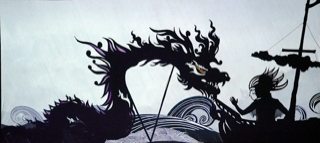
Shadow puppetry holds flat, almost two-dimensional puppets behind a screen. A lamp behind them projects their moving shadows on to the screen, and we, the happy audience, see the shadows form the other side. “The Cambridge Guide to Theatre” tells us that shadow puppetry in the Middle East was used to avoid the censors: Mercifully, Hamid Rahmanian doesn’t have to contend with censors. An Iranian-born artist, he’s conceived, designed and directed an elaborate shadow puppet theater piece, Feathers of Fire (in collaboration with Larry Reed and ShadowLight Productions). It’s inspired by “Shahnameh (The Book of Kings),” the Persian epic written in the tenth century by the poet Ferdowsi. It’s the longest work we know by a single poet, and Mr. Rahmanian has used only an excerpt. The story of Feathers of Fire concerns a boy disowned by his father—a great warrior—at birth because he has white hair. He’s raised by eagles—okay, probably by birds like eagles—and the story proceeds through his forbidden romance with the daughter of the Governor of Kabul. As in so many great myths, the young hero needs to answer riddles as part of the courtship. Of course, love conquers all. The shadow puppetry in Feathers of Fire is marvelous, absolutely terrific. It’s finely wrought, so delicate that we don’t understand how the puppeteers do it. There are wonderful stylized details—fractal clouds, a classically curled beard on the Father—even the fur on the Father’s collar is clear, even the lace on the Queen’s shawl. The characters are voiced. The shadows (160 puppets are used) are mostly black, but they have color in them, beautifully blended, as in the women’s hair and dress. There’s a soothsayer, an astrologer, and a couple of vizirs. There’s a winged lion and a terrifying sea monster. The backgrounds (video projections) are in color, with the detailed anarchy of vegetation—beautiful flowers—contrasting with the regular symmetry of buildings. Pillars pass across the screen evenly paced, and minarets define space. It’s as if mankind imposes beautiful order on the beautiful chaos of nature. That said, the buildings in the background sometimes (but only sometimes) take on the flat quality of the computer screen. Unfortunately, the script doesn’t match the excellence of the graphics. This super-stylized form, shadow puppetry, demands an equally stylized language—singing perhaps (some early shadow puppetry was accompanied by chant), or iambic pentameter. The Shahnameh itself has been translated into impressive iambic pentameter, beginning: However, in Feathers of Fire we get the patterns of day-to-day speech, simultaneously prosaic and awkward. We hear awful lines like “I’m in love. Is that a sin?” and “It is clear as day.” The word “guru” is used, an anachorism. Moreover, the voice of the young hero is too old for the character. Mr. Rahmanian has co-written the play with Vikas Menon. The marvelous puppets are handcrafted by Neda Kazemifar and Spica Wobbe, and the costumes are designed by Dina Zarif. There’s some lovely music by Loga Ramin Torkian and Azam Ali. Feathers of Fire is wonderful to watch, a sort of live animation, and we’d like to see more of this shadow puppetry, perhaps coupled with verse.
“Shadow puppet theatre similar to that found today throughout the East and South-East Asia was probably introduced to the Middle East at the time of the Mongol invasion of the 13th century. … Their [shadow puppets’] method of manufacture helped them deal with basic orthodox Islamic objections to their existence. Shadow puppet makers were able to circumvent these objections by pointing out that since the figures were perforated with holes, they no longer represent animate beings.”
His reign was thirty years, and o'er the earth
He spread the blessings of paternal sway;
Wild animals, obsequious to his will,
Assembled round his throne, and did him homage.
